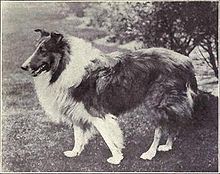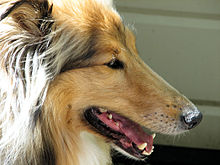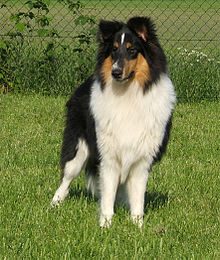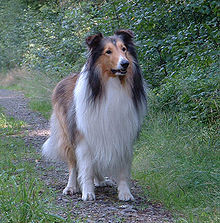- Rough Collie
-
Rough Collie 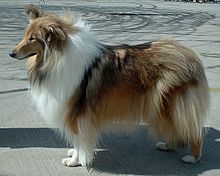
Sable and white Rough Collie Other names Collie, Scottish Collie, Long-Haired Collie, English collie Country of origin United Kingdom (Scotland) Traits Weight Male 20 to 34 kg (45 to 75 lb) Female 15.8 to 29 kg (35 to 65 lb) Height Male 55.8 to 66 cm (22 to 26 in) Female 50.8 to 61 cm (21 to 26 in) Coat long double coat Color sable, mahogany sable, shaded sable, tri-coloured, blue merle, sable merle, colour headed white, double merle Life span 12 to 14+ years Classification and standards FCI Group 1 Section 1 #156 standard AKC Herding standard ANKC Group 5 (Working dogs) standard CKC Group 7 - Herding dogs standard KC (UK) Pastoral standard NZKC Working standard UKC Herding Dogs standard Dog (Canis lupus familiaris) The Rough Collie (also known as the Long-Haired Collie) is a long coated breed of medium to large size dog that in its original form was a type of collie used and bred for herding in Scotland. Originating in the 1800's,[1] it is now well known through the works of author Albert Payson Terhune, and through the Lassie novel, movies, and television shows. There is also a smooth-coated variety; some breed organisations, including both the American and the Canadian Kennel Clubs, consider the smooth-coat and rough-coat dogs to be variations of the same breed. Rough Collies generally come in shades of sable, merles, and tri-coloured. This breed is very similar to the smaller Shetland Sheepdog which is partly descended from the Rough Collie.
Contents
History
Both Rough and Smooth collies are descended from a localised variety of herding dog originating in Scotland and Wales.[2] The Scottish variety was a large, strong, aggressive dog, bred to herd highland sheep. The Welsh variety was small and nimble, domesticated and friendly, and also herded goats. When the English saw these dogs at the Birmingham market, they interbred them with their own variety of sheepdogs producing a mixture of short and long haired varieties. After the industrial revolution, dog ownership became fashionable, and these early collies were believed to have been crossed with the Borzoi (Russian Wolfhound) to get a more "noble" head, which is today one of the true characteristics of the Rough Collie.[3] Though it is not known conclusively if the Borzoi cross made it into the mainstream of the breed. When Queen Victoria acquired a Rough Collie, after seeing one at Balmoral Castle, they were transformed into something of a fashion item.[2] Continued breeding for show purposes drastically changed the appearance of the dogs; in the 1960s, it was a much taller dog than it is today (in the UK; in the US, the size standard has not been revised downward and dogs have remained between 24-26"). Earlier dogs were also more sturdy in build and reportedly capable of covering up to 100 miles in one day. In the UK the Rough Collie is no longer used for serious herding, having been replaced by the Border Collie. Though in the United States and a number of European countries, there has been a resurgence in the use of the Collie as a working and performance dog.[4]
The Collie Club of America is one of the oldest breed-specific clubs in existence in the United States (founded in 1886). The Collie Club in England dates from 1881.[2]
Quoted from Collie Club of America:
Unfortunately, the Collie's exact origins are shrouded in obscurity. It has been the subject of much research and speculation. The word "Collie" is as obscure as the breed itself. The name has been spelled many different ways: Coll, Colley, Coally and Coaly. Generally, the most accepted origin of the word is "Coll" - the Anglo-Saxon word for "black". In the 18th century, the Rough Collie's natural home was in the highlands of Scotland, where he had been used for centuries as a sheepdog. The dogs were bred with great care in order to assist their masters in the herding and guarding of their flock. Without a doubt, it is to the English fancy of the late 1800s that the breed owes its development as a popular show dog. Rough Collies were first exhibited in 1860 at the Birmingham, England dog show, in the generic class "Scotch Sheep-Dogs". In 1879 the first English Rough Collie was imported to this country. It is from England that we find the famous pillars of the breed, from which the American fanciers sought not only their next big winner, but also their foundation stock. By the turn of the century, the American Rough Collie was in a state of continued development. The breed continued to flourish in England. American show prizes were dominated by the British imports. As a result of the imports, the breed made rapid progress between 1900 to 1920. These dogs built the foundations upon which the present day Rough Collie is based and paved the way for the emergence of the great American kennels of the 1920s and 1930s
The word may trace to Gaelic or/and Irish - in which the words for "doggie" are, respectively, càilean and cóilean. This would be more consistent with the breed's origin in the Gaelic-speaking Scottish Highlands than an Anglo-Saxon term.[citation needed]
Description
Appearance
Three coat colours are recognised for Rough Collies: sable and white, where the "sable" ranges from pale tan to a mahogany; tricolour, which is primarily black edged in tan; blue merle, which is mottled gray. All have white coat areas, in the collar, parts of the leg, and usually the tail tip. Some may have white blazes on their faces. In addition, the American Kennel Club accepts white, where the dog is predominantly white with coloured markings of sable, tricolour, or blue merle on the head and sometimes body patches.[5] Rough Collies have a blunter face than the smaller, but otherwise very similar Shetland Sheepdog, which is partly descended from the Rough Collie. The planes of the muzzle and the top of the skull should be parallel in collies, with a slight but distinct stop. (In shelties, the planes are not parallel.) The downy undercoat is covered by a long, dense, coarse outer coat with a notable ruff around the neck, feathers about the legs, a petticoat on the abdomen, and a frill on the hindquarters.[6][7]
The desired size and weight varies among breed standards; male collies can stand 55.8 to 66 cm (22 to 26 in) at the shoulder; the female averages 5 cm (2 in) shorter. The males are usually in the weight range (45 - 75 lbs) and the females are usually 5 to 10 lbs less. Although collies in the US are sometimes reported to be over a hundred pounds, this is a gross exaggeration for a healthy dog- a large collie typically weighs no more than 85 pounds. The UK standard calls for dogs to be significantly smaller than those under the American Kennel Club.[6][7]
One of the characteristic features of the Rough Collie is its head.[7][2] This is light in relation to the rest of the body, and resembles a blunted wedge tapering smoothly from ears to black nose, with a distinct stop and parallel head planes. The muzzle is well rounded, and never square. There is considerable variation in the colour of the head, however. The eyes are medium sized and almond shaped. The ears are supposed to be semi-prick, with the upper third folded over. Ears which do not 'tip' properly are fairly common, and many collies have their ears taped as puppies (using medical adhesive or paper tape) to encourage them to lay properly- no cutting or surgery is involved. They are similar to a Shetland Sheepdog's, but larger.
Once seen, the contrast between the Rough Collie head and that of a Border Collie is immediately apparent, the latter having a considerably shorter muzzle and a more distinct stop between muzzle and forehead. The ruff is also distinctive in distinguishing the two breeds.
Temperament
Rough collies should show no nervousness or aggression, and are generally good with children and other animals.[6][7] However, they must be well socialised to prevent shyness. They are medium to large sized dogs, but can be well suited to live in small apartments because of their calm disposition. Like many herding dogs, collies can be fairly vocal, and some are difficult to train not to bark. The amount of herding instinct varies, with some dogs being quite drivey and others calmer. Rough Collies are very loyal and may be one-family dogs (although most make exceptions for children), but are very rarely aggressive or protective beyond barking and providing a visual deterrent. They are typically excellent with children as long as they have been well-socialised and trained. They are eager to learn and respond best to a gentle hand. They relish human company and generally fare poorly as outdoor dogs.
Health
While Rough Collies are generally resilient and healthy, there are some health issues that can affect the breed.
Collie eye anomaly (CEA), a genetic disease which causes improper development of the eye and possible blindness, is a common ailment in the breed.[8] More rarely, Rough Collies can be affected by progressive retinal atrophy (PRA), another genetic disease in which bilateral degeneration of the retina results in progressive vision loss culminating in blindness.[9] Through genetic testing and careful screening program it would be theoretically possible to eradicate both of these problems in purebred lines, however, certainly in the UK, the Kennel Club does not require these tests to be done either for registration or showing. CEA is so prevalent that elimination of affected dogs except through very slow and careful breeding decisions to avoid shrinking the gene pool more than absolutely necessary. Rough Collie puppies should be screened at an early age (6–8 weeks) by a certified veterinary ophthalmologist to check for CEA. PRA has a later onset and can be detected by DNA test, but is much less widespread (in the US) than CEA. (In the UK, PRA is more common.) [10] Note, the UK Kennel Club "Accredited Breeder Scheme" requires eye tests and recommends the genetic test for this class of members ,.[11]
Canine cyclic neutropenia is a cyclic blood disorder that is usually fatal to affected puppies. The disease is also referred to as "gray collie syndrome", due to affected puppies having a pale gray, pinkish/gray or beige colouring, none of which are normal Rough Collie colours. Puppies that survive through adulthood are plagued with immune disorders throughout their lives and rarely live more than three years. DNA testing can help detect carriers of the recessive gene that causes the disease.[12]
Hip dysplasia: As with most of the larger breeds, hip dysplasia is a potential concern for Rough Collies. Although this disease appears to be "multigene", careful selection by many breeders is reducing this problem. The UK Kennel Club "Accredited Breeder Scheme" requires hip-scores this class of members ,[11] however, a very small proportion of UK registered puppies are bred under this scheme. Hip dysplasia is rare in collies compared to their closest relatives and other breeds of the same size.
Rough Collies may carry a mutant Mdr1 gene that results in a sensitivity to Ivermectin and related drugs. A screening test is used to determine if alternative medications are required. Overdoses from the proscribed medications can result in neurological imparement or even death. This faulty gene is present in several breeds, but is well known among collies.[13]
In addition to these problems, all of which can be tested for, there are a number of problems which are thought to be genetic but for which no screening test exists. These include epilepsy, bloat, a tendency towards allergies, and thyroid disorders (primarily hypothyroidism.). Because no DNA tests exist for these disorders (and all can have causes other than genetic origins), breeders can only do their best to avoid producing them by removing affected dogs from the gene pool.
Grooming
The double layered coat needs to be brushed frequently and thoroughly to keep it in a show condition. Pet dogs need less maintenance but still a significant amount. The profuse coat picks up grass seeds and burrs, and many dogs tend to mat to some degree, particularly behind the ears, around the collar (if a collar is left on the dog), and in the pants. Shaving collies is very bad for their skin and some do not regrow any significant amount of hair after being shaved. Spaying and neutering can alter coat texture, making it softer and more prone to matting. Individuals who like collies but do not love grooming are strongly recommended to consider a smooth collie instead.
Working Life
Herding
Activities
Rough Collies can compete in dog agility trials, obedience, showmanship, flyball, tracking, and herding events. Herding instincts and trainability can be measured at noncompetitive herding tests. Rough Collies exhibiting basic herding instincts can be trained to compete in herding trials.[14] The breed has also been known to work as search and rescue dogs, therapy dogs and guide dogs for the blind.[15]
Notable Rough Collies
- Lassie, a line of Rough Collies originally owned by Rudd Weatherwax that have starred in numerous films, multiple television series, a radio program, and has been the subject of various novels and non-fiction works. One of the few animal actors to have a star on the Hollywood Walk of Fame.
- DR Dakota, was the collie that performed the action shots in the latest Lassie Movie.
- Lad, the main hero of Albert Payson Terhune's early 20th century novels about his Sunnybank Rough Collies.
- Pal, the first Rough Collie to portray Lassie and from whom the Lassie line is descended.
- Ch. Laund Loyalty of Bellhaven, a nine-month-old Rough Collie who is the youngest dog to ever win the Westminster Kennel Club Dog Show.[16][17]
- Reveille III-VIII, the mascot of Texas A&M University.
- Colleen, a Rough Collie from London (voiced by Tress MacNeille) on Road Rovers.
- Jezebel, is a Rough Collie (voiced by Fergie) in the 2010 movie, Marmaduke.
- Chester McDoogle, is a Rough Collie that appeared in the promos for Chadwick Stokes album Simmerkane II of State Radio and Dispatch fame.
- Wilson, a Rough Collie who appears in the Japanese manga series Ginga: Nagareboshi Gin.
- The helpful Rough Collie (voiced by Tom Conway) , from 101 Dalmatians. He leads Pongo, Perdita and the puppies into the safety of a dairy farm somewhere in Hertfordshire.
- Sam, Martin Riggs' dog who appears in every movie from the Lethal Weapon franchise.
- Rob Roy and Prudence Prim, famous snow white Rough Collies owned by President Calvin and First Lady Gracie Coolidge.
- Laddie, a parody of Lassie on The Simpsons episode Canine Mutiny
- Zeb, dog from Olney, Maryland popular in the mid-Atlantic states as a "spokesdog" for Collie Rescue.
- Pip, dog from Bolton, England famous local rescue dog.
- Mason, who portrayed the last "Lassie" in the latest Lassie Movie.
See also
References
- ^ "NZKC Breed Standard". New Zealand Kennel Club. http://www.nzkc.org.nz/br520.html. Retrieved 18 May 2011.
- ^ a b c d Wharton, Alice (1998). Collies. ISBN 0-7938-2800-7.
- ^ Clark, Anne Rogers and Brace, Andrew H. (eds.), ed (10 1995). "The Breeds: Collies - Rough Collie". The International Encyclopedia of Dogs (1st (American) ed.). New York, New York: Howell Book House. pp. 188–190. ISBN 978-0876056240. OCLC 32697706.
- ^ Dorsten, Cindy M., A Celebration of the Working Collie,edition=1st (American) year=2002, [Alpine Publications,Loveland,Colorado|isbn=1-57779-001-4|
- ^ "Collie Colours". http://pages.videojug.com/pages/353-Collie-Colours-the-whole-story.
- ^ a b c "Collie Breed Standard". American Kennel Club. 1977-05-10. http://www.akc.org/breeds/collie/index.cfm. Retrieved 2008-02-08.
- ^ a b c d "Collie (Rough) Breed Standard". The Kennel Club. 2006-05-12. http://www.thekennelclub.org.uk/item/132. Retrieved 2008-02-08.
- ^ "Inherited Retinopathies". The Merck Veterinary Manual. 2006. http://www.merckvetmanual.com/mvm/index.jsp?cfile=htm/bc/30114.htm. Retrieved 2008-02-14.
- ^ Gelatt, Kirk N. (ed.) (1999). Veterinary Ophthalmology (3rd ed.). Lippincott, Williams & Wilkins. ISBN 0-683-30076-8.
- ^ "Eye Disease in Collies". Collie Health Foudation. http://www.colliehealth.org/eyes.html. Retrieved 2008-02-14.
- ^ a b "Accredited Breeder Recommendationas and Requirements". UK Kennel club. http://www.thekennelclub.org.uk/download/1100/abshealthreqs.pdf. Retrieved 2008-02-28.
- ^ "Canine Cyclic Neutropenia". Collie Health Foundation. http://www.colliehealth.org/gray.html. Retrieved 2008-02-14.
- ^ "The Ivermectin Story". Collie Health Foundation. http://www.colliehealth.org/ivermectin.html. Retrieved 2008-04-10.
- ^ Hartnagle-Taylor and Taylor, Jeanne Joy, Ty (2010). Stockdog Savvy. Alpine Publications. ISBN #978-157779-106-5..
- ^ Mitchell, P.. "Rough Collie". Canada's Guide to Dogs. http://www.canadasguidetodogs.com/collierough.htm. Retrieved 18 May 2011.
- ^ "WKC Dog Show - Past Winners of Best in Show". Westminster Kennel Club. http://www.westminsterkennelclub.org/history/biswinners.html. Retrieved 2008-02-15.
- ^ "WKC Dog Show - Best in Show Records". Westminster Kennel Club. http://www.westminsterkennelclub.org/history/bisrecords.html. Retrieved 2008-02-15.
External links
Categories:- Dog breeds
- Herding dogs
- Dog breeds originating in Scotland
Wikimedia Foundation. 2010.

